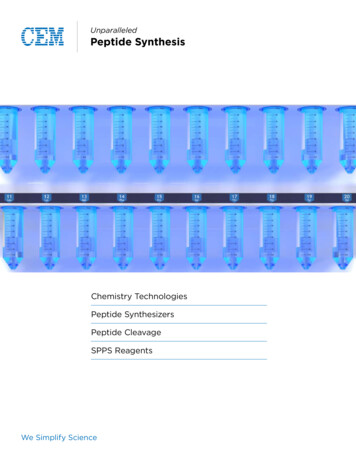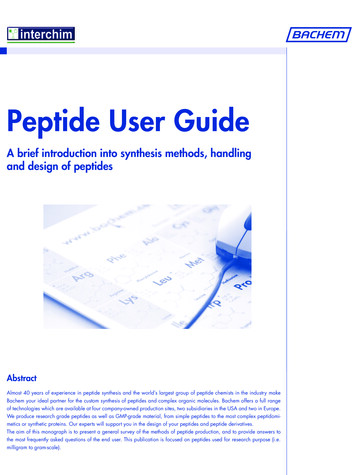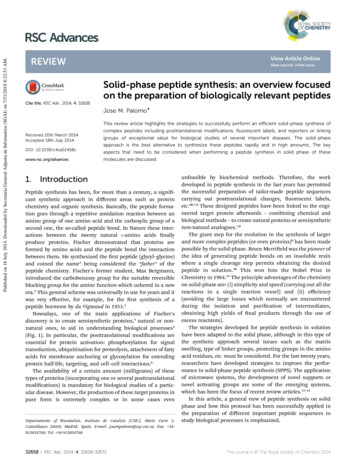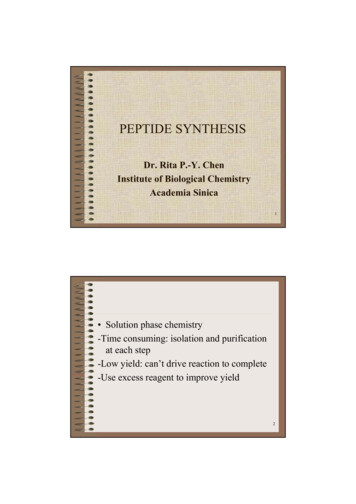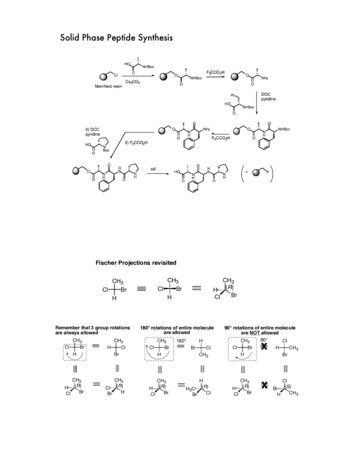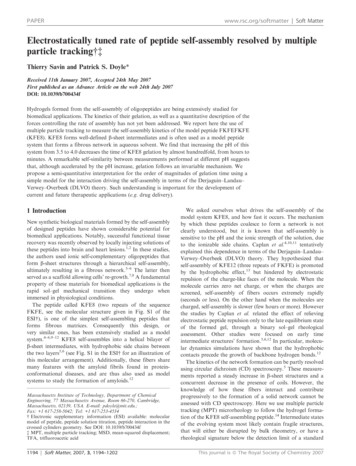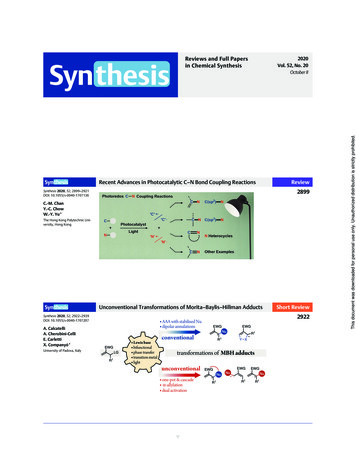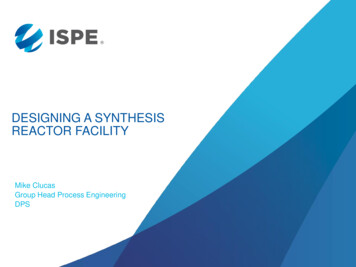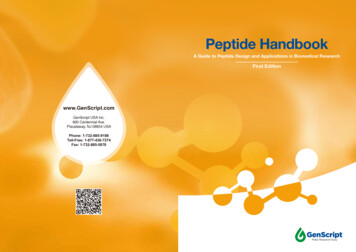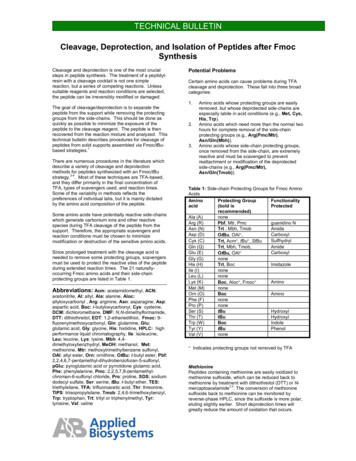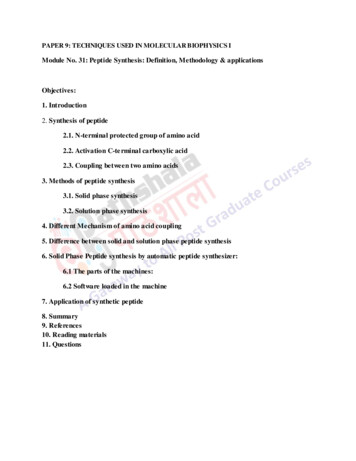
Transcription
PAPER 9: TECHNIQUES USED IN MOLECULAR BIOPHYSICS IModule No. 31: Peptide Synthesis: Definition, Methodology & applicationsObjectives:1. Introduction2. Synthesis of peptide2.1. N-terminal protected group of amino acid2.2. Activation C-te rminal carboxylic acid2.3. Coupling between two amino acids3. Methods of peptide synthesis3.1. Solid phase synthesis3.2. Solution phase synthesis4. Different Mechanism of amino acid coupling5. Difference between solid and solution phase peptide synthesis6. Solid Phase Peptide synthesis by automatic peptide synthesizer:6.1 The parts of the machines:6.2 Software loaded in the machine7. Application of synthetic peptide8. Summary9. References10. Reading materials11. Questions
Peptides are present in living cell as enzyme, hormone, antibiotic, and receptor and have diversebiochemical activities. It is very important and interesting to develop the synthetic peptide in thelaboratory. The main objectives of peptide synthesis are:1. To study the relationship between structure function relationship of biologically activeprotein and peptides and establish their molecular mechanisms.2. To synthesize peptides those are of clinically importance such as antibiotic, vaccines andother drugs.3. To develop new peptide-based kits for immunogen.1. IntroductionEmil Fischer defined in 1901 [1] the peptide bond as the amide- like linkage between amino acidsand chosen the term peptide which was called peptones in Fisher’s day are the mixtures ofpeptides formed on the proteases on proteins. Peptide has various crucial roles in biologicalsystem. It governs the structural and functional properties of bioactive proteins which isimportant objective in biological and medical research.Amino acids and peptidesPeptides and proteins are prime important in the regulation and maintenance of all biologicalprocesses.The variation in properties of peptide and proteins depends on the nature of the side chain ofamino acids:i) Some amino acids partially transfer the protein and give rise to hydrogen bond interaction likeM .H .Xii) Some completely transfer the proton and form an ion and they are acidic in natureiii) Some amino acids can accept proton easily due to the presence of free amino group which arebasic in nature-NH2 H -----NH3Under physiological condition in neutral solution, amino acid acts as a double ion or Zwitterionof the form
NH3 --------CHR----COO Hydrophobic amino acids – side chains are non-polar. They are water hating group and usuallylocated interior of the protein. Hydrophobic interaction is the important aspects for the stabilityof the protein.Eg: Phenylalanine (F), Glycine (G), Alanine (A), Isoleucine (I), Leucine (L), Valine (V)Basic amino acids – positively charged at physiological pH. They are usually involved inelectrostatic interaction with negatively charged group of amino acids. They are usually occur inenzyme active sites as it can functions as very efficient general acid-base catalyst.Eg: Arginine (R), Lysine (K), Histidine (H)Acidic amino acids – They are negatively charged in physiological pH. They are most oftenfound on the surface of the protein where they can interact with favorable solvent molecules.They take part in electrostatic interaction with positively charged amino ac ids.They take part in catalytic role in active sites of the enzyme and well known for their metal- ionbinding capabilities.Eg; Aspartic acid (D), Glutamic acid (E)Properties of diffe rent amino acidsGlycine (G) – It is very flexible due to the absence of side chain. It frequently found in the turnregion of the protein where the backbone has to make sharp turn.Alanine (A), Valine (V), Leucine (L), Isoleucine (I) Phenylalanine (F) – They do not have anyreactive group on their side chain, so they do not interact with water but interact with each otherand non-polar atoms which is the main factor in stabilizing the folded confirmation of protein.Serine (S), Threonine (T) – ‘S’ has OH group and ‘T’ has CH2 -OH group which are not verychemically reactive.Aspartic acid (D), Glutamic acid (E) - Difference between D and E is only one methylenegroup. This slight difference in the length of the side chain causes to have different tendencies oftheir chemical interaction with peptide backbone. They have differe nt effects of theconformation and chemical reactivity of the peptide backbone. They are found on the surface ofthe protein where they can easily interact with solvent molecules and take part in electrostaticinteractions with positively charged basic amino acids.Tyrosine (Y), Tryptophan (W) – These residues are nearly found buried in the hydrophobicinterior of the proteins as they are predominantly non-polar in nature. They allow hydrogen
bonding interaction to be made with other residues or even solvent molecules due to the presenceof OH and NH group in their side chain.Cysteine (C), Methionine (M) – C and M are non-polar have a unique property of being able toform a covalent cross- link with another C residue elsewhere in the protein, thus forming adisulphide bridge involve –S-S- bond between two C residues. C frequently occur at metalbinding sites as their sulphur atoms can form native covalent bond with central metal ions.Histidine (H), Lysine (K), Arginine (R) – These basic amino acids occur very frequently inenzyme active sites as it can function as a very efficient acid-base catalyst and also acts as ametal ion ligand in numerous protein families. Leucine (L), Histidine (H) and Arginine (R) arestrongly basic and are usually involved in electrostatic interactions with negatively chargedgroup such as Aspartic acid (D), Glutamic acid (E). They have important roles in anion bindingproteins as they can interact electrostatically with ligand.Aspargine (N), Glutamine (Q) – They have amide group in their side chains which are usuallyhydrogen bonded whenever they occur in the interior of the proteinProline (P) – Proline is the most rigid of the twenty amino acids since it’s side chain iscovalently linked with main chain nitrogen.PeptidesThe peptide bond is formed between amino group of one amino acid with carbonyl group of nextamino acid by the formation of amide bond and one molecule of water.The peptide bond is planer and short bond length between C’ – N and C’ – O.C’ – N 1.33 Å (normally it is 1.47 Å)C’ – O 1.24 Å (normally it is 1.43 Å)This shortening of the bond length is due to the delocalization of double bond of the carbonylgroup into the C’ – N bond.O C – C’- N- C C – C N’ - C HHBecause of resonance the six atoms shown above tend to lie on a same plane. C and N havetrigonal planar sp3 orbital.
The shortness of the bond and partial double bond character gives more strength and rotationaround the bond is restricted and gives rise to a planer structure. So the peptide bond; NH – COis planar and always in trans configuration. C and C C’ are always in trans to each otherwith respect to peptide bond C’ – N.Rotation around C’ – N is restricted and the flexibility of polypeptide chain is only due to therotation around C’ - C and C Why peptide:i) Restriction of conformational flexibility will lead to higher degree of predictabilityii) Highly active; small amount is required for biological functioniii) Highly specific and have therefore relatively low systematic toxicity. Do notaccumulate in the body for short half lifeiv) Easily acceptable by body, with very low side effect. 2. Synthesis of peptideThe peptide synthesis is occur by coupling between two amino acids and formation of peptidebond between carboxyl group one amino acid to amino group of another amino acid.Synthesis of peptide coupling between two amino acids required the following steps:i) Protection of N-terminal group of one amino acid and C-terminal of other amino acid byprotected group.ii) Activation of C—terminal of carboxy group of amino acid which is protect by N-terminalprotected group.iii) Coupling reaction: Mixing two amino acids to form an amide bond and release watermolecule.2.1. N-terminal protected group of amino acid
i) Boc- Tertiary butyl carbonyl chloride is added dropwise during one hour to a well stirredsolution of amino acid in NaOH and t-BuOH [2].De-protection:Boc group is de-protected by tri- fluoro acetic acid (TFA)ii) Z- Benzyloxycarbonyl chloride is added to amino acid in NaOH and waterDeprotection:Deprotected by catalytic hydrogenation.iii) Fmoc - Fluorenylmethyloxycarbonyl chloride is added to amino acid [3].De-protected by piperidineProtected carboxyl group: by methyl or ethyl group
Methyl or ethyl group is attached to carboxyl group of amino acid by methylation and ethylationwith methyl or ethyl alcoholDeprotection: it can deprotect by hydrolysis with NaOH.2.2. Activation C-te rminal carboxylic acidSynthetic peptide coupling requires the activation of the C-terminal carboxylic acid on theincoming amino acid using carbodiimides such as dicyclohexylcarbodiimide (DCC) ordiisopropylcarbodiimide (DIC).2.3. Coupling between two amino acids : The coupling of two amino acids form an amide bondsPrecautionary reagents: the activating group of DCCI forms highly reactive O-acylisoureaintermediate that is quickly displaced by nucleophilic attack from the deprotected primary aminogroup on the N-terminus of the growing peptide chain to form the nascent peptide bond.Carbodiimides form such a reactive intermediate that racemization of the amino acid can occur.Therefore, reagents that react with the O-acylisourea intermediate are often added, including 1hydroxybenzotriazole (HOBt), which forms a less-reactive intermediate that reduces the risk ofracemization. Additionally, side reactions caused by carbodiimides have led to the examinationof other coupling agents, including benzotriazol-1-yl-oxy-tris (dimethylamino) hosphate (HBTU), which both require activating bases to mediate amino acidcoupling.3. Methods of peptide synthesisThere are two methods for synthesis: solid and solution phase3.1. Solid phase synthesis: Solid phase synthesis was first introduced in 1963 by Merrifield [4].It involves the successive addition of amino acids to form a linear peptide chain. C-terminus ofthe first amino acid is covalently bound to a solid support called resin and the chain of aminoacid binds from the N-terminal of the amino acid. Four steps chemical reactions are repeated foreach amino acids that is added to the peptide chain: de-protection, activation, coupling andcleavage of resin.
i) Protected amino acid is removed to make the alpha- amino group on the end of the peptidechain accessible.ii) Activation converts the next amino acid to be added to an active ester.iii) Activation converts the next amino acid to be added to an active ester. During coupling theactive ester forms an amide bond with the de-protected alpha- amino group on the end of thepeptide chain. After coupling new cycle of synthesis begins with the next de-protection.iv) Cleavage of resin uses different reagents depending upon the resin used for solid support. Theside chain protecting groups also remove during cleavage.Types of resin:i). Wang resin [5]:Cleavage – Wang resin is cleave by trifluoroacetic acid (TFA)ii) Pam resin:Cleavage – Pam resin is cleave by Trifluoromethane sulphonic acid (TFMSA)iii) Merrifield resin:
Cleavage- Merrifield resin is cleaved by stable dimethyl ether–poly(hydrogen fluoride)(DMEPHF).Precautionary reagents : Some amino acids like C,M,W,Y,T have a potentially reactive sidechain for the formation of carbonium ion called carbocation during cleavage with acid. So toprevent carbocation various scavengers are used like anisole and thioanisole.Water is also added with scavenger to suppress alkylation.Kaiser’s Test:The completion of coupling is tested manually by Kaiser’s test for the presence of free aminogroup (Kaiser et al 1970)[6]. Three solutions are required for this testSolution A: Ninhydrin in ethanolSolution B: Phenol in ethanolSolution C: Potassium cyanide in pyridine.Add two drops from each solvent to few beads of resin, heat in 100 o C water bath. Free aminogroup gives blue colour beads which show the incomplete coupling and white colour beads showthe absence of free amino group.3.2. Solution phase synthesis: Solution phase synthesis is a classical method which was firstintroduced by scientist for peptide synthesis. In this method, C-terminal of one amino acid isprotected by ethyl of methyl ester and couple with another N-terminal protected amino acid.After each coupling peptide is isolated and purified and proceed for next coupling.4. Different Mechanism of amino acid coupling:i) Mixed anhydride couplingii) DCCI/HOBt couplingiii) Salt couplingiv) Acyl halide and pseudo halide coupling5. Difference between solid and solution phase peptide synthesisSolid PhaseSolution phaseSolid polymer support at C-terminal end isNo solid support is required. C terminal isrequiredprotected with methyl or ethyl groupThe synthesis is always proceed via N-terminal Synthesis is possible from both N and C
sideOne pot reactionterminal side.Isolation and purification is required afterevery step of coupling.Very slow and labour- intensive as product hasto isolate after every coupling manually.Yield is low as it looses at every step ofwashing after coupling.Very rapid methodYield is very high6. Solid Phase Peptide synthesis by automatic peptide synthesizer:The machine is fully automated microprocessor controlled instrument for peptide synthesis. Ithas a software consist of menu includes deprotection, washing, activation and coupling .6.1 The parts of the machines:i) Three reaction vesselsii) Four solvent bottles: 2 reaction solvent bottles1 De-protector bottle1 Activator bottleiii) One rack with the capacity of 45 amino acid vialsiv) LCD with front panel controlv) Connector to connect with nitrogen cylinder to run the machine6.2 Software loaded in the machine : There six programs in the machine to run each steps of thesynthesis as well as manual run. The programs are built for washing, de-protection, activation,coupling and repetition of coupling.
The cleavage of resin after peptide synthesis is not included in the machine, so peptide resinmanually cleaved by using the reagent required for it.7. Application of synthetic peptidei) To study enzyme substrate kinetic reactionii) To determine the structure of naturally occurring peptide since they are resemble.iii) To mass spectrometry for characterization and quantification of proteinsiv) To determine the structure-activity relationship of biologically active proteins andpeptidev) Use as a drugvi) Use as diagnostic reagent8. Summaryi) Easy to synthesizeii) Less immunogeniciii) Easily absorbed through metabolism as any other biomoleculesiv) Can mimic protein-protein interactionv) High therapeutic index with low toxicityvi) Chemical and biological diversity
3. Methods of peptide synthesis There are two methods for synthesis: solid and solution phase 3.1. Solid phase synthesis: Solid phase synthesis was first introduced in 1963 by Merrifield [4]. It involves the successive addition of amino acids to form a linear peptide chain. C-terminus of
